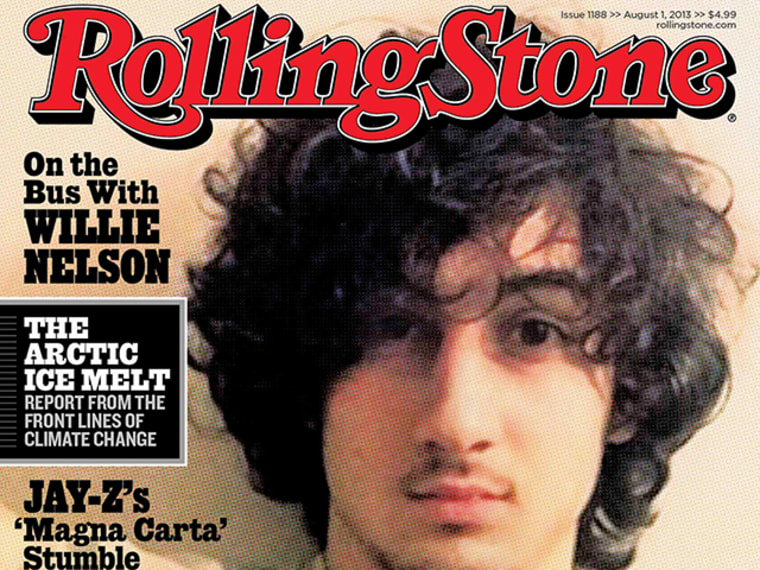Rolling Stone may end up proving that there's no such thing as bad publicity.
The magazine likely won't be hurt by the social media firestorm and subsequent boycott over putting one of the alleged Boston bombers on the front cover. On the contrary, it could even see a boost, experts said on Thursday.
"It may be seen as a bad decision to put a criminal or a killer on the cover, but Rolling Stone took a gamble," said Samir Husni, director of the magazine innovation center at the University of Mississippi. "In the long-term this is not going to hurt them."
The reason? Most of the magazine's 1.46 million circulation comes from subscriptions.
At least five retailers, including CVS and Walgreens, said they will not sell the Rolling Stone issue featuring Boston Marathon bombing suspect Dzhokhar Tsarnaev on its cover.
The picture, which accompanies a story titled "Jahar's World," shows the 19-year-old accused murderer with tousled hair, reminiscent of the magazine's iconic shots of rock stars like The Doors' Jim Morrison and Bob Dylan.
The issue — which hits newsstands Friday — depicts Tsarnaev above the headline, "The Bomber." The story, which features interviews with childhood friends, teachers and law enforcement agents, promises to reveal how a “popular, promising student was failed by his family, fell into radical Islam, and became a monster."
"I don't think anybody truly believes this will hurt Rolling Stone," said Linda Ruth, a magazine publishing consultant with PSCS in New Hampshire.
"Rolling Stone knew going in they would get kicked out by retailers," she said. "What they get here is bigger than what they lose."
Rolling Stone, like most U.S. magazines, is subscription-driven. According to ABC (Audit Bureau of Circulations), its newsstand sales are just 75,000 out of a total circulation of over 1.4 million last year.
"Newsstand sales are only a tiny proportion. But Rolling Stone also got more publicity than money can buy," Husni said, suggesting the controversy could help the magazine add more sales.
"They probably won't even notice this (boycott)," said Ryan Chittum, who covers business stories for the Columbia Journalism Review. "There may be a few cancellations but no big deal."
Husni also said there was a misconception that Rolling Stone is only about music and popular culture. "Rolling Stone is one of the few magazines still publishing in-depth and long-form investigative articles in the U.S.
"This is nothing new to Rolling Stone," he said of the magazine, which won a National Magazine Award for its 1970 prison interview with mass murderer Charles Manson, who was featured on the cover.
Two years ago, Rolling Stone's story on Gen. Stanley McChrystal, commander of U.S. forces in Afghanistan, included unflattering comments about Vice President Joe Biden and other White House House officials and led to McChrystal's resignation.
"Unfortunately, the public is emotionally driven and this mass hysteria is the biggest threat to journalism," said Husni. "This is not Kim Kardashian, this is a serious mag and journalists cannot be driven by public opinion. You can't allow the public to dictate what journalists do."
He said people were comparing the cover photo to Dylan or Morrison or Bono. "That's the problem. The glamorization of the photo shows that people did not read the article."
Rolling Stone was co-founded by Jann Wenner who is still owner and chief editor. It has always been known for its musical coverage and for political reporting by journalists such as Hunter S. Thompson. But in the 1990s, Wenner changed its format to appeal to a younger readership interested in TV, movie stars and popular music.
It was not the only magazine cover to spark controversy. Time magazine had a woman breastfeeding her toddler son on its cover recently and there was a very pregnant and very naked Demi Moore on the front of Vanity Fair, while The New Yorker had Sesame Street's Bert and Ernie snuggling on a couch as they watch the Supreme Court justices on TV after the Defense of Marriage Act decision.
"The number of people who never read Rolling Stone who buy this issue will outnumber the people who boycott it," said Bob Thompson, professor of popular culture at Syracuse University.
He said it stirred up emotions because people like to think of terrorists and criminals as inhuman monsters. "That cover made him look human, like us, and that makes people nervous," said Thompson. "If they had used the police mug-shot, there would be no issue.
"Some bad publicity can be very useful," said Thompson.
